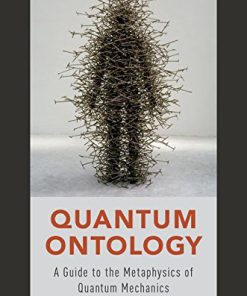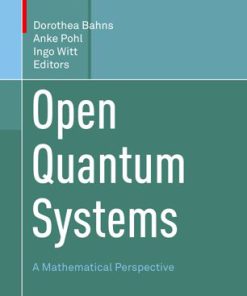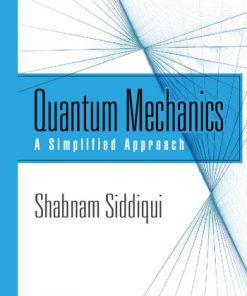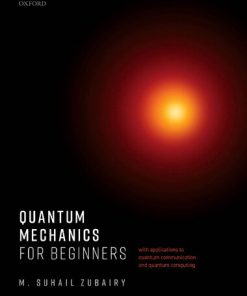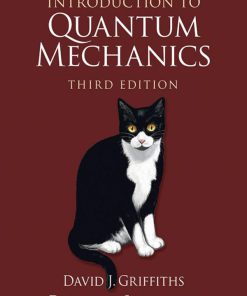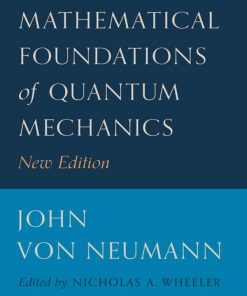A Mathematical Companion to Quantum Mechanics 1st Edition by Shlomo Sternberg ISBN 0486839826 9780486839820
$50.00 Original price was: $50.00.$25.00Current price is: $25.00.
A Mathematical Companion to Quantum Mechanics 1st Edition by Shlomo Sternberg – Ebook PDF Instant Download/Delivery: 0486839826, 9780486839820
Full download A Mathematical Companion to Quantum Mechanics 1st Edition after payment
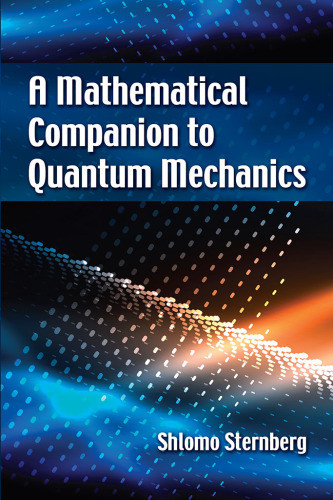
Product details:
ISBN 10: 0486839826
ISBN 13: 9780486839820
Author: Shlomo Sternberg
This original 2019 work, based on the author’s many years of teaching at Harvard University, examines mathematical methods of value and importance to advanced undergraduates and graduate students studying quantum mechanics. Its intended audience is students of mathematics at the senor university level and beginning graduate students in mathematics and physics. Early chapters address such topics as the Fourier transform, the spectral theorem for bounded self-joint operators, and unbounded operators and semigroups. Subsequent topics include a discussion of Weyl’s theorem on the essential spectrum and some of its applications, the Rayleigh-Ritz method, one-dimensional quantum mechanics, Ruelle’s theorem, scattering theory, Huygens’ principle, and many other subjects.
A Mathematical Companion to Quantum Mechanics 1st Table of contents:
1 Introduction
2 The Fourier Transform
2.0.1 Conventions
2.1 Basic Facts about the Fourier Transform Acting on S
2.1.1 The Fourier Transform on L2
2.2 Tempered Distributions
2.3 The Laplace Transform
2.3.1 The Mellin Inversion Formula
3 The Spectral Theorem, I
3.1 The Exponential Series for a Bounded Operator
3.2 The Functional Calculus A → f (A)
3.3 Gelfand’s Formula for the Spectral Radius
3.3.1 Normal Operators
3.3.2 The Spectrum of an Element in an Algebra
3.3.3 The Spectral Radius
3.3.4 Gelfand’s Proof of the Spectral Theorem for Bounded Self-adjoint Operators
3.4 Non-negative Operators
4 Unbounded Operators
4.1 Unbounded Operators
4.1.1 Linear Operators and Their Graphs
4.1.2 The Resolvent and the Resolvent Set
4.1.3 The Adjoint of a Densely Defined Linear Operator
5 Semi-groups, I
5.1 The Bounded Case
5.1.1 The Resolvent from the Semi-group
5.1.2 The Semi-group from the Resolvent
5.1.3 The Two Resolvent Identities
5.2 Sectorial Operators
5.2.1 Definition of et A When A Is Sectorial
5.2.2 The Integral Converges and Is Independent of r
5.2.3 The Semi-group Property
5.2.4 Bounds on et A
5.2.5 The Derivatives of et A, Its Holomorphic Character
5.2.6 The Limit of et A as t → 0+
5.2.7 The Resolvent as the Laplace Transform of the Semi-group
6 Self-adjoint Operators
6.1 Recall about Unbounded Operators and Their Spectra
6.2 The Spectrum of a Self-adjoint Operator Is Real
7 Semi-groups, II
7.1 Equibounded Continuous Semi-groups
7.1.1 The Infinitesimal Generator
8 Semi-groups, III
8.1 Using the Mellin Inversion Formula
8.2 The Hille-Yosida Theorem
8.2.1 Contraction Semi-groups
8.3 The Spectral Theorem, Functional Calculus Form
8.3.1 The Functional Calculus for Functions in S
8.4 The Dynkin-Helffer-Sjöstrand Formula
8.4.1 Symbols
8.4.2 Slowly Decreasing Functions
8.4.3 Stokes’ Formula in the Plane
8.4.4 Almost Holomorphic Extensions
8.4.5 The Dynkin-Helffer-Sjöstrand Formula
8.4.6 The Dynkin-Helffer-Sjöstrand Formula for the Resolvent
8.4.7 Davies’ Proof of the Spectral Theorem
8.5 Monotonicity
8.6 Dissipative Operators, the Lumer-Phillips Theorem
8.7 The Key Points of the Preceding Chapters
9 Weyl’s Theorem on the Essential Spectrum
9.1 An Example, the Square Well in One Dimension
9.2 The Kato-Rellich Theorem, the Notion of a Core
9.3 The Spectrum as “Approximate Eigenvalues”
9.3.1 An Alternative Approach Using the Born Approximation
9.3.2 There Is No Spectrum of the Square Well Hamiltonian below −K
9.4 The Discrete Spectrum and the Essential Spectrum
9.4.1 Characterizing the Essential Spectrum
9.4.2 A Slightly Different Characterization of the Essential Spectrum
9.5 The Stability of the Essential Spectrum
9.5.1 Preview: How We Will Use Weyl’s Theorem
9.5.2 Proof That A + B Is Self-adjoint
9.5.3 Proof That the Essential Spectrum of A Is Contained in the Essential Spectrum of A + B
9.5.4 Proof That the Essential Spectrum of A Contains the Essential Spectrum of A + B
9.6 The Domain of H0 in One Dimension
9.7 Back to the Square Well (in One Dimension)
9.7.1 The Eigenvalues for the Square Well Hamiltonian
9.7.2 Tunneling
10 More from Weyl’s Theorem
10.1 Finite Rank Operators
10.1.1 A Compact Operator Is the Norm Limit of Finite Rank Operators
10.2 Compact Operators
10.3 Hilbert Schmidt Operators
10.3.1 Hilbert Schmidt Integral Operators
10.3.2 A More General Definition of Hilbert Schmidt Operator
10.3.3 An Important Example
10.4 Using Weyl’s Theorem for H0 + V
10.4.1 Applications to Schrödinger Operators
10.5 The Harmonic Oscillator
10.5.1 Weyl’s Law
10.5.2 Verifying Weyl’s Law for the Harmonic Oscillator
10.6 Potentials in L2 ⊕ L∞ in R3
11 Extending the Functional Analysis via Riesz
11.1 Integration According to Daniel
11.2 A Riesz Representation Theorem for Measures
11.3 Verifying That f ↦ O(f) Is a Functional Calculus
12 Wintner’s Proof of the Spectral Theorem
12.1 Self-adjoint Operators and Herglotz Functions
12.1.1 Herglotz Functions
12.1.2 The Borel Transform or the Stieltjes Transform
12.2 The Measure μx.x
12.2.1 The Measure μx.y
12.3 The Spectral Theorem via Wintner
12.4 Partitions of Unity or Resolutions of the Identity
12.5 Stone’s Formula and the Stieltjes Inversion Formula
13 The L2 Version of a Spectral Theorem
13.1 The Cyclic Case
13.1.1 Cyclic Vectors
13.1.2 The Isometry U in the Cyclic Case
13.1.3 The General Case
13.2 Fractional Powers of a Non-negative Operator
13.2.1 Non-negative Operators
13.2.2 The Case 0 < λ < 1
13.2.3 The Case λ = , the Quadratic Form Associated with a Non-negative Self-adjoint Operator
13.3 The Lax-Milgram Theorems
13.3.1 Gelfand’s Rigged Hilbert Spaces
13.3.2 The Hermitian Case—Lax-Milgram-III
13.4 Semi-bounded Operators and the So-called Friedrichs Extension
13.4.1 Semi-bounded Operators
13.4.2 The Friedrichs Extension
13.5 Hardy’s Inequality and the Hydrogen Atom
13.5.1 Hardy’s Inequality
14 Rayleigh-Ritz
14.1 The Rayleigh-Ritz Method
14.1.1 The Hydrogen Molecule
14.1.2 The Heitler-London “Theory” (1927)
14.1.3 Variations on the Variational Formula
14.1.4 The Secular Equation
14.2 Back to Chemistry: Valence
14.2.1 Two-dimensional Examples
14.2.2 The Hückel Theory of Hydrocarbons
15 Some One-dimensional Quantum Mechanics
15.1 Introduction
15.2 The Sturm Comparison Theorem and Its Consequences
15.2.1 The Sturm Oscillation Theorem
15.2.2 A Dichotomy
15.2.3 Comparison of Two Equations
15.2.4 Application to Eigenvectors
15.3 Using the Quadratic Form H (f, g) and Rayleigh-Ritz
15.3.1 The Quadratic Form H(f, g)
15.4 Perron-Frobenius-Krein-Rutman
15.5 Variational Principles, Glazman’s Lemma
15.6 The Zeros of Eigenvectors in Higher Dimensions
16 More One-dimensional Quantum Mechanics
16.1 Introduction
16.2 Some Computations in One Dimension
16.2.1 Motion under the Free Hamiltonian, Spreading of the Wave Packet
16.2.2 The Resolvent of the Free Hamiltonian in One Dimension
16.3 Some Elementary Scattering Theory in One Dimension
16.3.1 On the Far Field Behavior of Solutions of the Wave Equation in One Dimension
16.3.2 The Free Problem
16.3.3 The Jost Solutions
16.3.4 A Brief Excursion about Wronskians
17 Some Three-dimensional Computations
17.1 The Yukawa Potential in Three Dimensions
17.1.1 The Yukawa Potential and the Resolvent
17.1.2 The Time Evolution of the Free Hamiltonian
18 Bound States and Scattering States
18.1 Introduction
18.2 The Mean Ergodic Theorem
18.3 Recall: The Kato-Rellich Theorem
18.4 Characterizing Operators with Purely Continuous Spectrum
18.5 The RAGE Theorem
18.5.1 The Spaces M0 and M∞
18.5.2 Using the Mean Ergodic Theorem
18.5.3 The Amrein-Georgescu Theorem
18.6 Kato Potentials
18.7 Ruelle’s Theorem
19 The Exponential Decay of Eigenstates
19.1 Introduction
19.2 The Agmon Metric
19.3 Agmon’s Theorem
19.3.1 Conjugation and Commutation of H0 by a Multiplication Operator
19.4 Some Inequalities
19.5 Completion of the Proof
20 Lorch’s Proof of the Spectral Theorem
20.1 The Riesz-Dunford Calculus
20.1.1 The Riemann Integral over a Curve
20.1.2 Lorch’s Proof of Gelfand’s Formula for the Spectral Radius
20.1.3 Stone’s Formula
20.2 Lorch’s Proof of the Spectral Theorem
20.2.1 The Point Spectrum
20.2.2 Operators with Pure Point Spectrum
20.2.3 Partition into Pure Types
20.2.4 Completion of Lorch’s Proof
21 Scattering Theory via Lax and Phillips
21.1 Notation
21.1.1 Examples
21.2 Incoming and Outgoing Subspaces
21.3 Breit-Wigner
21.4 Strongly Contractive Semi-groups
21.5 The Sinai Representation Theorem
21.5.1 The Sinai Representation Theorem
21.5.2 The Stone-von Neumann Theorem
21.6 The Stone-von Neumann Theorem
21.6.1 The Heisenberg Algebra and Group
21.6.2 The Stone-von Neumann Theorem
22 Huygens’ Principle
22.1 Introduction
22.2 d’Alembert and Duhamel
22.3 Fourier Analysis
22.3.1 Using the Fourier Transform to Solve the Wave Equation
22.3.2 Conservation of Energy at Each Frequency
22.3.3 Distributional Solutions
22.4 The Radon Transform
22.4.1 Definition of the Radon Transform
22.4.2 Using the Fourier Inversion Formula for the Wave Equation
22.4.3 Huygens’ Principle in Odd Dimensions > 1
23 Some Quantum Mechanical Scattering Theory
23.1 Introduction
23.1.1 Notation
23.1.2 The Spaces M+ and M−
23.1.3 Scattering States and the Scattering Operator
23.2 The Scattering Operator
23.3 Properties of the Wave and Scattering Operators
23.3.1 Invariance Properties of M± and R±
23.3.2 Cook’s Lemma
23.3.3 The Chain Rule
23.4 “Time Independent Scattering Theory”
23.4.1 Expressing the Wave Operators in Terms of the Resolvents
23.4.2 A Perturbation Series for the Wave Operators
23.5 Meromorphic Continuation of the Resolvents
23.6 The Lippmann-Schwinger Equation—A Reference
24 The Groenewold-van Hove Theorem
24.1 Poisson Algebra, Notation
24.1.1 The Polynomials of Degree ≤ 2 Form a Maximal Poisson Sub-algebra of the Algebra of All Polynomials
24.1.2 The Action of sp(2) on Homogeneous Polynomials
24.1.3 Maximality of the Polynomials of Degree ≤ 2
24.1.4 Expressing q2 p2 in Two Different Ways as Poisson Brackets
24.2 A Change in Notation to Self-adjoint Operators
24.3 Proof of the Groenewold-van Hove Theorem
25 Chernoff’s Theorem
25.1 Convergence of Semi-groups
25.1.1 Resolvent Convergence
25.2 Chernoff’s Theorem
25.2.1 Lie’s Formula
25.2.2 Statement of Chernoff’s Theorem
25.2.3 Proof of Chernoff’s Theorem
25.3 The Trotter Product Formula
25.3.1 Commutators
25.3.2 Feynman “Path Integrals” from Trotter
25.3.3 The Feynman-Kac Formula
26 Some Background Material
26.1 Borel Functions and Borel Measures
26.2 The Basics of the Geometry of Hilbert Space
26.2.1 Scalar and Semi-scalar Products
26.2.2 The Cauchy-Schwarz Inequality
26.2.3 The Triangle Inequality
26.2.4 Pre-Hilbert Spaces
26.2.5 Normed Spaces
26.2.6 Completion
26.2.7 The Pythagorean Theorem
26.2.8 The Theorem of Apollonius
26.2.9 Orthogonal Complements
26.2.10 The Problem of Orthogonal Projection
26.2.11 Orthogonal Projection
26.3 The Riesz Representation Theorem for Hilbert Spaces
26.3.1 Linear and Antilinear Maps
26.3.2 Linear Functions
26.3.3 The Riesz Representation Theorem
26.3.4 Proof of the Riesz Representation Theorem
26.4 The Riemann-Lebesgue Lemma
26.4.1 The Setup
26.4.2 The Averaging Condition
26.4.3 The Riemann-Lebesgue Lemma
26.5 The Riesz Representation Theorem for Measures
26.5.1 Partitions of Unity (in the Topological Sense) and Urysohn’s Lemma
26.5.2 Urysohn Implies Uniqueness
26.5.3 Tentatively Defining the Appropriate σ-Algebra
26.5.4 Countable Sub-additivity of μ in General
26.5.5 Countable Additivity for Elements of ΩB
26.5.6 Proof That ΩB Is a σ-algebra
26.5.7 A Decomposition Theorem
People also search for A Mathematical Companion to Quantum Mechanics 1st:
a mathematical companion to quantum mechanics
a mathematical companion to quantum mechanics pdf
a mathematical comparison
quantum mechanics commutator
quantum mechanics and complex numbers
Tags:
Shlomo Sternberg,
You may also like…
Physics - Quantum Mechanics
A Course in Quantum Mechanics 1st Edition by Nandita Rudra 1000527438 9781000527438
Physics - Quantum Physics
Quantum Mechanics A Fundamental Approach 1st Edition K. Kong Wan
Politics & Philosophy - Anthropology
Quantum Ontology: A Guide to the Metaphysics of Quantum Mechanics 1st Edition Peter J. Lewis
Physics - Quantum Physics
Open Quantum Systems A Mathematical Perspective Dorothea Bahns
Computers - Networking
Physics - Quantum Mechanics





